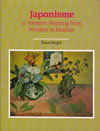
CC. The Larger Context
 |
|||
| The fullest and most rewarding study of Japonisme available. |
9. Berger, Klaus. Japonisme in Western Painting from Whistler to Matisse. Translated by David Britt. Cambridge: Cambridge UP, 1992. Originally published as Japonismus in der westlichen Malerei 1860-1920. Munich: Prestel-Verlag, 1980.
Berger’s scrupulous scholarship, attention to detail, and careful analyses combine to make this the fullest and most rewarding study of Japonisme available. The work demonstrates that the European and American turn to Japanese models in the years following 1850 ‘was not a passive process of reception but the active operation of a triggering factor’, which lead first to ‘the imitation of individual motifs’ and then to ‘stylistic assimilation’ and finally to ‘creative transformation’ in the work of many of the most important European and American painters of the time. ‘The response to the Japanese vision modified the relationship between content and form in Western art’, Berger writes in an Afterword (in Britt’s translation). ‘Wherever the dead hand of academicism or naturalistic platitude threatened to paralyse the imagination, a Japanese inspiration intervened’, and this led ultimately to ‘the unfolding of new modes of formal creation’. The work is richly illustrated, and includes in the first of two appendices a detailed chronology of important events in the historical development of the subject. See also 11.

